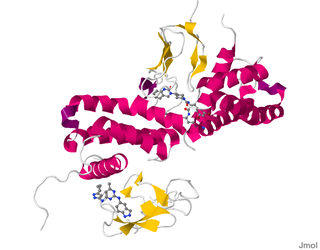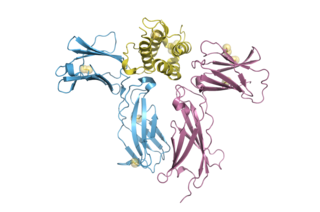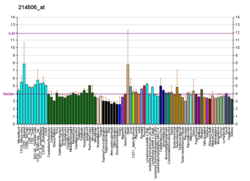
Pleiotrophin (PTN) also known as heparin-binding brain mitogen (HBBM) or heparin-binding growth factor 8 (HBGF-8) or neurite growth-promoting factor 1 (NEGF1) or heparin affinity regulatory peptide (HARP) or heparin binding growth associated molecule (HB-GAM) is a protein that in humans is encoded by the PTN gene. Pleiotrophin is an 18-kDa growth factor that has a high affinity for heparin. It is structurally related to midkine and retinoic acid induced heparin-binding protein.

Adrenomedullin is a vasodilator peptide hormone of uncertain significance in human health and disease. It was initially isolated in 1993 from a pheochromocytoma, a tumor of the adrenal medulla: hence the name.

Receptor activity modifying protein 2, also known as RAMP2, is a protein which in humans is encoded by the RAMP2 gene.

Receptor activity modifying protein 3, also known as RAMP3, is a human gene.

Bradykinin receptor B2 is a G-protein coupled receptor for bradykinin, encoded by the BDKRB2 gene in humans.

Calcitonin receptor-like (CALCRL), also known as the calcitonin receptor-like receptor (CRLR), is a human protein; it is a receptor for calcitonin gene-related peptide.

The alpha-1A adrenergic receptor, also known as ADRA1A, formerly known also as the alpha-1C adrenergic receptor, is an alpha-1 adrenergic receptor, and also denotes the human gene encoding it. There is no longer a subtype α1C receptor. At one time, there was a subtype known as α1C, but it was found to be identical to the previously discovered α1A receptor subtype. To avoid confusion, the naming convention was continued with the letter D.

Probable G-protein coupled receptor 45 is a protein that in humans is encoded by the GPR45 gene.

Probable G-protein coupled receptor 63 is a protein that in humans is encoded by the GPR63 gene.

Probable G-protein coupled receptor 85 is a protein that in humans is encoded by the GPR85 gene.

Hematopoietic lineage cell-specific protein is a protein that in humans is encoded by the HCLS1 gene.

Interleukin 12 receptor, beta 2 subunit is a subunit of the interleukin 12 receptor. IL12RB2 is its human gene. IL12RB2 orthologs have been identified in all mammals for which complete genome data are available.

60S ribosomal protein L6 is a protein that in humans is encoded by the RPL6 gene.

Serine/threonine-protein kinase PLK2 is an enzyme that in humans is encoded by the PLK2 gene.

ATP-binding cassette sub-family D member 2 is a membrane pump/transporter protein that in humans is encoded by the ABCD2 gene.

Vasohibin-1 is a protein that in humans is encoded by the VASH1 gene.

Zinc finger protein 161 homolog is a protein that in humans is encoded by the ZBTB14 gene.

Tyrosine-protein phosphatase non-receptor type 23 is an enzyme that in humans is encoded by the PTPN23 gene.

Cytokine receptor-like factor 2 is a protein that in humans is encoded by the CRLF2 gene. It forms a ternary signaling complex with TSLP and interleukin-7 receptor-α, capable of stimulating cell proliferation through activation of STAT3, STAT5 and JAK2 pathways and is implicated in the development of the hematopoietic system. Rearrangement of this gene with immunoglobulin heavy chain gene (IGH), or with P2Y purinoceptor 8 gene (P2RY8) is associated with B-progenitor- and Down syndrome- acute lymphoblastic leukemia (ALL).

Coiled-coil domain-containing protein 80 is a protein that in humans is encoded by the CCDC80 gene. Bioinformatics analysis suggests the CCDC80 protein is a peroxiredoxin.



















